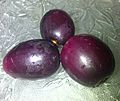Syzygium facts for kids
Quick facts for kids Syzygium |
|
|---|---|
 |
|
| Syzygium aromaticum (the clove plant) | |
| Scientific classification | |
| Kingdom: | |
| (unranked): | |
| (unranked): | |
| (unranked): | |
| Order: | |
| Family: | |
| Genus: |
Syzygium
|
| Species | |
|
About 1100; see text |
|
Syzygium (say "siz-ZYE-jee-um") is a large group of flowering plants. These plants belong to the myrtle family, called Myrtaceae. There are about 1200 to 1800 different kinds, or species, of Syzygium.
You can find Syzygium plants naturally from Africa and Madagascar. They also grow across southern Asia and eastward into the Pacific Ocean. The most different types of Syzygium are found from Malaysia to northeastern Australia. Many of these species are still not fully known or described by scientists.
Contents
What are Syzygium Plants Like?
Most Syzygium species are evergreen trees and shrubs. This means they keep their leaves all year round. Many are grown as ornamental plants because their leaves are shiny and attractive.
Edible Fruits and Spices
Some Syzygium plants produce fruits that people can eat. These fruits are often eaten fresh or made into jams and jellies. The most important species for people is the clove plant, Syzygium aromaticum. The unopened flower buds of this plant are a very important spice used in cooking around the world.
Many edible Syzygium species are planted in warm, tropical areas. Some have become invasive species in certain island ecosystems. This means they grow so well that they can take over and harm local plants.
Australian Syzygium Species
In Australia, there are 52 known species of Syzygium. They are commonly called lillipillies, brush cherries, or satinash. Many of these also have fruits that are safe for humans to eat. These fruits are often called "roseapples" because of their shape and color.
How Scientists Study Syzygium
For a long time, Syzygium was sometimes mixed up with another plant group called Eugenia. The Eugenia group has about 1000 species and is mostly found in Central and South America.
Many plants that were once called Eugenia are now part of the Syzygium group. However, the old name might still be used by gardeners. In 2016, a group of scientists from around the world formed the Syzygium Working Group. Their goal is to create a complete book, or monograph, about all the Syzygium species.
Images for kids
-
Syzygium paniculatum (magenta lilly pilly)
-
Syzygium samarangense, with a cross section of the fruit
See also
 In Spanish: Syzygium para niños
In Spanish: Syzygium para niños





